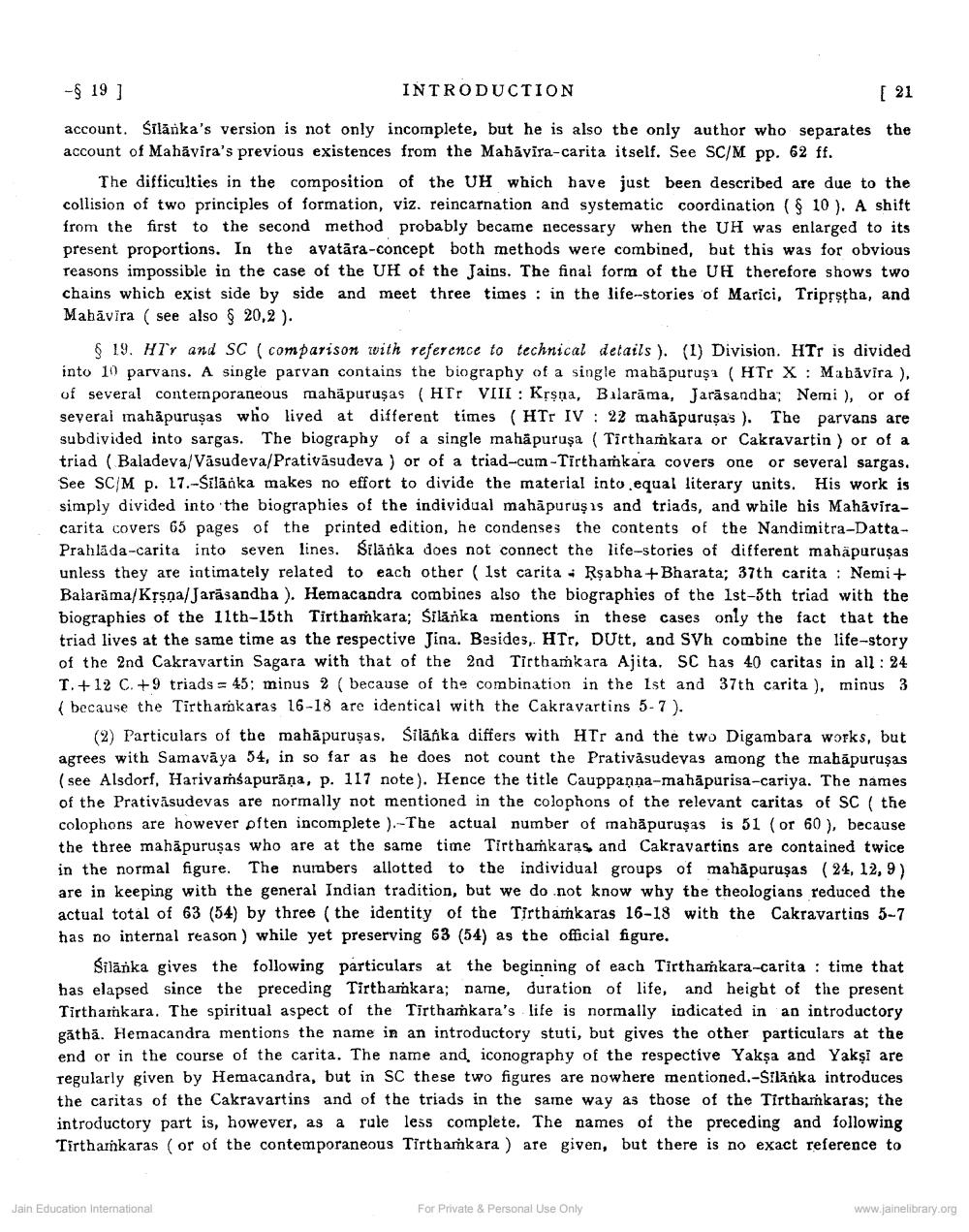________________
-$ 19 ]
INTRODUCTION
[ 21
account. Silanka's version is not only incomplete, but he is also the only author who separates the account of Mahāvira's previous existences from the Mahāvīra-carita itself. See SC/M pp. 62 ff.
The difficulties in the composition of the UH which have just been described are due to the collision of two principles of formation, viz. reincarnation and systematic coordination ( 10 ). A shift from the first to the second method probably became necessary when the UH was enlarged to its present proportions. In the avatāra-concept both methods were combined, but this was for obvious reasons impossible in the case of the UH of the Jains. The final form of the UH therefore shows two chains which exist side by side and meet three times : in the life-stories of Marici, Triprstha, and Mahāvira (see also $ 20,2).
$ 19. HTY and SC (comparison with reference to technical details ). (1) Division. HTr is divided into 10 parvans. A single parvan contains the biography of a single mabäpuruşa (HTr X: Mabăvira ). of several contemporaneous mahāpuruşas (HIr VIII : Krsna, Balarama, Jarāsandha; Nemi), or of several mahāpuruşas who lived at different times (HTr IV : 22 mahāpuruşas ). The parvans are subdivided into sargas. The biography of a single mahāpuruşa ( Tirthamkara or Cakravartin ) or of a triad (Baladeva/Vasudeva/Prativasudeva ) or of a triad-cum-Tirthamkara covers one or several sargas. See SC/M p. 17.-Silanka makes no effort to divide the material into.equal literary units. His work is simply divided into the biographies of the individual mahāpuruşıs and triads, and while his Mahaviracarita covers 65 pages of the printed edition, he condenses the contents of the Nandimitra-DattaPrahlada-carita into seven lines. Silānka does not connect the life-stories of different mahäpurusas unless they are intimately related to each other (1st carita - Rşabha+Bharata; 37th carita : Nemi + Balarama/Krsna/Jarasandha ). Hemacandra combines also the biographies of the 1st-5th triad with the biographies of the 11th-15th Tirthamkara; Silärka mentions in these cases only the fact that the triad lives at the same time as the respective Jina. Besides, HTr, DUtt, and SVh combine the life-story of the 2nd Cakravartin Sagara with that of the 2nd Tirthamkara Ajita, SC has 40 caritas in all : 24 T. +12 C. +9 triads = 45: minus % (because of the combination in the 1st and 37th carita ). minus 3 (because the Tirtharkaras 16-18 are identical with the Cakravartins 5-7).
(2) Particulars of the mahāpuruṣas. Silārka differs with HTr and the two Digambara works, but agrees with Samavāya 54, in so far as he does not count the Prativåsudevas among the mahāpuruşas (see Alsdorf, Harivarsapurāņa, p. 117 note). Hence the title Cauppanna-mahāpurisa-cariya. The names of the Prativasudevas are normally not mentioned in the colophons of the relevant caritas of SC ( the colophons are however pften incomplete ).--The actual number of mahăpuruşas is 51 (or 60 ), because the three mahāpurusas who are at the same time Tirtharkaras and Cakravartins are contained twice in the normal figure. The numbers allotted to the individual groups of mahāpurusas (24, 12,9) are in keeping with the general Indian tradition, but we do .not know why the theologians reduced the actual total of 63 (54) by three (the identity of the Tirthamkaras 16-18 with the Cakravartias 5-7 has no internal reason ) while yet preserving 63 (54) as the official figure.
Šilānka gives the following particulars at the beginning of each Tirthamkara-carita : time that has elapsed since the preceding Tirthamkara; name, duration of life, and height of the present Tirthamnkara. The spiritual aspect of the Tirtharkara's life is normally indicated in an introductory gătha. Hemacandra mentions the name in an introductory stuti, but gives the other particulars at the end or in the course of the carita. The name and iconography of the respective Yakşa and Yakşi are regularly given by Hemacandra, but in SC these two figures are nowhere mentioned.-Silānka introduces the caritas of the Cakravartins and of the triads in the same way as those of the Tirthakaras; the introductory part is, however, as a rule less complete. The names of the preceding and following Tirthakaras (or of the contemporaneous Tirthamkara ) are given, but there is no exact reference to
Jain Education International
For Private & Personal Use Only
www.jainelibrary.org




